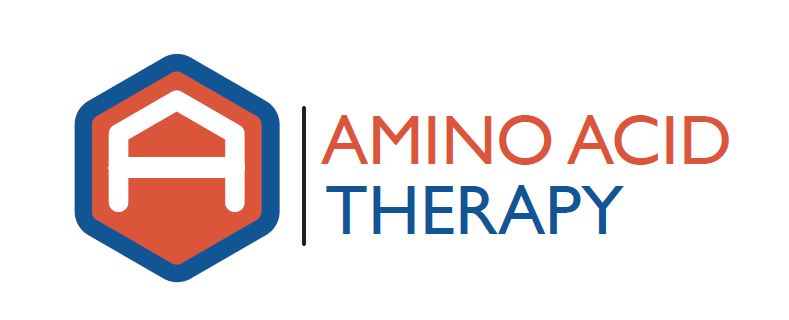by aatadmin | Nov 22, 2017 | Amino Acid Therapy, dopamine dominance, Neurotransmitters, Symptoms of Neurotransmitter Imbalance
 Amino acid therapy involves the determination and administration of the amino acids and cofactors needed to optimize neurotransmitter function. In the vast majority of cases, this involves trying to optimize the function of the “centrally acting monoamines” which include serotonin, dopamine, norepinephrine and epinephrine. The centrally acting monoamines are synthesized from nutrients, including L-tryptophan, 5-HTP, L-tyrosine and L-dopa. These centrally acting monoamines form a system in which serotonin and the catecholamines (which include dopamine, norepinephrine and epinephrine) oppose one another; in other words, optimizing the function of the centrally acting monoamines involves more than just giving ‘more’ of one precursor or the other; it also involves getting the balance right between them. (more…)
Amino acid therapy involves the determination and administration of the amino acids and cofactors needed to optimize neurotransmitter function. In the vast majority of cases, this involves trying to optimize the function of the “centrally acting monoamines” which include serotonin, dopamine, norepinephrine and epinephrine. The centrally acting monoamines are synthesized from nutrients, including L-tryptophan, 5-HTP, L-tyrosine and L-dopa. These centrally acting monoamines form a system in which serotonin and the catecholamines (which include dopamine, norepinephrine and epinephrine) oppose one another; in other words, optimizing the function of the centrally acting monoamines involves more than just giving ‘more’ of one precursor or the other; it also involves getting the balance right between them. (more…)
by aatadmin | Oct 25, 2017 | Amino Acid Therapy, Neurotransmitters, Symptoms of Neurotransmitter Imbalance
 There is a lot of confusion about what we are trying to accomplish through the targeted use of amino acid therapy, so I wanted to devote this post to (a) the dysfunction(s) we are trying to address and (b) how amino acid therapy addresses these dysfunctions. (more…)
There is a lot of confusion about what we are trying to accomplish through the targeted use of amino acid therapy, so I wanted to devote this post to (a) the dysfunction(s) we are trying to address and (b) how amino acid therapy addresses these dysfunctions. (more…)
by aatadmin | Sep 27, 2017 | Adrenal Fatigue, Amino Acid Therapy, dopamine dominance, Symptoms of Neurotransmitter Imbalance
 Every so often we encounter a case where we have seemingly found a person’s optimized dose of amino acids – meaning that whatever symptoms they were experiencing (i.e., depression, anxiety, urges to pull, migraines, tremor, inability to sleep, etc.) have been significantly reduced and/or eliminated – when ‘out of the blue’ their original symptoms return. This can present itself at anytime, but is most typical after a few weeks or months (3-4 months is most common) on the amino acids at the optimized dose. Before the client or provider begins to change anything (or panic) there are a couple of things that MUST be done to insure accurate and optimal results. (more…)
Every so often we encounter a case where we have seemingly found a person’s optimized dose of amino acids – meaning that whatever symptoms they were experiencing (i.e., depression, anxiety, urges to pull, migraines, tremor, inability to sleep, etc.) have been significantly reduced and/or eliminated – when ‘out of the blue’ their original symptoms return. This can present itself at anytime, but is most typical after a few weeks or months (3-4 months is most common) on the amino acids at the optimized dose. Before the client or provider begins to change anything (or panic) there are a couple of things that MUST be done to insure accurate and optimal results. (more…)
by aatadmin | Sep 13, 2017 | Amino Acid Therapy, dopamine dominance, Symptoms of Neurotransmitter Imbalance
 There are a lot of disorders related to neurotransmitter dysfunction, including depression, anxiety, insomnia, migraines, trichotillomania, OCD, RLS and Parkinson’s disease, among others. The vast majority of people with these conditions (aside from RLS and Parkinson’s) are serotonin dominant, which means that these people normally require much more support for serotonin than the catecholamines (dopamine, norepinephrine and epinephrine) in order to optimize neurotransmitter function. On the opposite end of the spectrum are those people that are dopamine dominant; this includes people with RLS and Parkinson’s Disease. In addition, there is a small group of people with conditions that are typically serotonin dominant (roughly between 6-12%) that actually end up needing significant dopamine support (i.e, they are dopamine dominant). The only way to determine this is via specialized urine testing. To make matters more complicated, it turns out that there is a third group of people that need significant support for both the serotonin and catecholamine systems; these people are typically labeled “hybrids”. (more…)
There are a lot of disorders related to neurotransmitter dysfunction, including depression, anxiety, insomnia, migraines, trichotillomania, OCD, RLS and Parkinson’s disease, among others. The vast majority of people with these conditions (aside from RLS and Parkinson’s) are serotonin dominant, which means that these people normally require much more support for serotonin than the catecholamines (dopamine, norepinephrine and epinephrine) in order to optimize neurotransmitter function. On the opposite end of the spectrum are those people that are dopamine dominant; this includes people with RLS and Parkinson’s Disease. In addition, there is a small group of people with conditions that are typically serotonin dominant (roughly between 6-12%) that actually end up needing significant dopamine support (i.e, they are dopamine dominant). The only way to determine this is via specialized urine testing. To make matters more complicated, it turns out that there is a third group of people that need significant support for both the serotonin and catecholamine systems; these people are typically labeled “hybrids”. (more…)
by aatadmin | Aug 16, 2017 | Amino Acid Therapy, Neurotransmitters, Symptoms of Neurotransmitter Imbalance
 Our first post in this series established the role that transporters play in establishing optimal neurotransmitter synthesis, metabolism and reuptake. Again, based on the work of Marty Hinz, MD, Alvin Stein, MD and Thomas Uncini, MD, the Organic Cation Transporter Type 2 (OCT-2) seems to be the dominant transport system with regards to serotonin and the catecholamines (to learn more, please read The dual-gate lumen model of renal monoamine transport and APRESS: apical regulatory super system, serotonin,and dopamine interaction). Let’s learn a bit more how and why these gates work and how we can optimize their function using amino acid therapy. (more…)
Our first post in this series established the role that transporters play in establishing optimal neurotransmitter synthesis, metabolism and reuptake. Again, based on the work of Marty Hinz, MD, Alvin Stein, MD and Thomas Uncini, MD, the Organic Cation Transporter Type 2 (OCT-2) seems to be the dominant transport system with regards to serotonin and the catecholamines (to learn more, please read The dual-gate lumen model of renal monoamine transport and APRESS: apical regulatory super system, serotonin,and dopamine interaction). Let’s learn a bit more how and why these gates work and how we can optimize their function using amino acid therapy. (more…)
by aatadmin | Aug 2, 2017 | Amino Acid Therapy, Neurotransmitters, Symptoms of Neurotransmitter Imbalance
 Neurotransmitter dysfunction is the root cause of a whole host of disorders, including depression, anxiety, insomnia, OCD, ADD/ADHD, migraines, trichotillomania, RLS and Parkinson’s disease. Every disorder that has been linked to centrally acting monoamines (i.e., serotonin, dopamine, norepinephrine and/or epinephrine) occurs because inadequate amounts of serotonin, dopamine, norepinephrine and/or epinephrine exists. In order to optimize neurotransmitter function, the total number of these neurotransmitters needs to be increased in the system, the synapse or both. (more…)
Neurotransmitter dysfunction is the root cause of a whole host of disorders, including depression, anxiety, insomnia, OCD, ADD/ADHD, migraines, trichotillomania, RLS and Parkinson’s disease. Every disorder that has been linked to centrally acting monoamines (i.e., serotonin, dopamine, norepinephrine and/or epinephrine) occurs because inadequate amounts of serotonin, dopamine, norepinephrine and/or epinephrine exists. In order to optimize neurotransmitter function, the total number of these neurotransmitters needs to be increased in the system, the synapse or both. (more…)
 Amino acid therapy involves the determination and administration of the amino acids and cofactors needed to optimize neurotransmitter function. In the vast majority of cases, this involves trying to optimize the function of the “centrally acting monoamines” which include serotonin, dopamine, norepinephrine and epinephrine. The centrally acting monoamines are synthesized from nutrients, including L-tryptophan, 5-HTP, L-tyrosine and L-dopa. These centrally acting monoamines form a system in which serotonin and the catecholamines (which include dopamine, norepinephrine and epinephrine) oppose one another; in other words, optimizing the function of the centrally acting monoamines involves more than just giving ‘more’ of one precursor or the other; it also involves getting the balance right between them. (more…)
Amino acid therapy involves the determination and administration of the amino acids and cofactors needed to optimize neurotransmitter function. In the vast majority of cases, this involves trying to optimize the function of the “centrally acting monoamines” which include serotonin, dopamine, norepinephrine and epinephrine. The centrally acting monoamines are synthesized from nutrients, including L-tryptophan, 5-HTP, L-tyrosine and L-dopa. These centrally acting monoamines form a system in which serotonin and the catecholamines (which include dopamine, norepinephrine and epinephrine) oppose one another; in other words, optimizing the function of the centrally acting monoamines involves more than just giving ‘more’ of one precursor or the other; it also involves getting the balance right between them. (more…)
 There is a lot of confusion about what we are trying to accomplish through the targeted use of amino acid therapy, so I wanted to devote this post to (a) the dysfunction(s) we are trying to address and (b) how amino acid therapy addresses these dysfunctions.
There is a lot of confusion about what we are trying to accomplish through the targeted use of amino acid therapy, so I wanted to devote this post to (a) the dysfunction(s) we are trying to address and (b) how amino acid therapy addresses these dysfunctions.  Every so often we encounter a case where we have seemingly found a person’s optimized dose of amino acids – meaning that whatever symptoms they were experiencing (i.e., depression, anxiety, urges to pull, migraines, tremor, inability to sleep, etc.) have been significantly reduced and/or eliminated – when ‘out of the blue’ their original symptoms return. This can present itself at anytime, but is most typical after a few weeks or months (3-4 months is most common) on the amino acids at the optimized dose. Before the client or provider begins to change anything (or panic) there are a couple of things that MUST be done to insure accurate and optimal results.
Every so often we encounter a case where we have seemingly found a person’s optimized dose of amino acids – meaning that whatever symptoms they were experiencing (i.e., depression, anxiety, urges to pull, migraines, tremor, inability to sleep, etc.) have been significantly reduced and/or eliminated – when ‘out of the blue’ their original symptoms return. This can present itself at anytime, but is most typical after a few weeks or months (3-4 months is most common) on the amino acids at the optimized dose. Before the client or provider begins to change anything (or panic) there are a couple of things that MUST be done to insure accurate and optimal results.  There are a lot of
There are a lot of 
